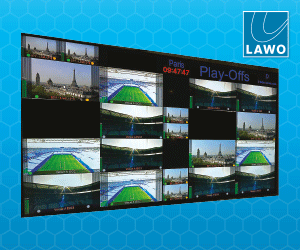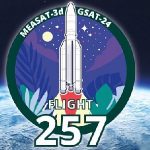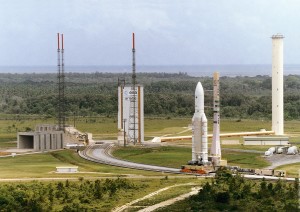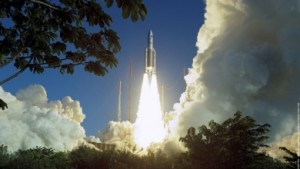The successful launch of Eutelsat 8 West B brings much needed additional capacity to the MENA region. We were in French Guiana, exclusively, to witness the launch of the satellite
 One of the most prominent factors on any space enthusiasts bucket list is to watch a rocket take off into the depths of space. Theres nothing quite like it, and even though some people consider satellite launches as passé, as there have been so many of them, only someone with a lingering passion for space would truly appreciate the grand spectacle of sending a metal bird into the cosmos.
One of the most prominent factors on any space enthusiasts bucket list is to watch a rocket take off into the depths of space. Theres nothing quite like it, and even though some people consider satellite launches as passé, as there have been so many of them, only someone with a lingering passion for space would truly appreciate the grand spectacle of sending a metal bird into the cosmos.
Arianespaces Flight VA225 was ready for launch on August 20, 2015. Onboard the launch vehicle were two satellites, Eutelsats Eutelsat 8 West B and Intelsats Intelsat 34. The time for the launch was set at 1710, Kourou time in French Guiana.
The rocket was moved out to the launchpad 48-hours prior, and checks, pre-checks, more checks and then furthermore checks made sure that every single component of the launch vehicle and its payload was in prime condition for a smooth liftoff.
The Jupiter room was the nerve centre of the launch, and in the left corner of the room was a screen that had different lights that showed every aspect of the health of the package. Green was the colour that everyone was looking for. In the event any one of those lights turned red, there was an issue that required immediate attention. Luckily, on the morning of the launch, nothing looked amiss. Everything was going just fine, when for the first time in eight years, in French Guianas dry season in August, it began to drizzle. The sky was overcast and an uneasy panic set in. It was only 1100. Perhaps the skies would clear closer to launch. After all, the launch window was quite large, and ranged from 1710 to 1856, Kourou time. Everyone tried to stay optimistic. The weather check at the time of launch and status of the rocket showed no critical anomaly.
The countdown to liftoff comprises all final preparation steps for the launcher, the satellites/spacecraft and the launch site. It culminates in a synchronised sequence, managed by the control station and onboard computers starting at T-7 minutes. Any anomaly could stop the countdown in its tracks and delay liftoff by a few hours or even days, depending on the severity of the problem.
About three hours prior to launch, there was a build-up of a huge military presence near the space centre. It is protocol to close all roads leading to the space centre one day prior and one day post launch. The Air Force and Navy was also called in to ensure there was no air or maritime traffic in the vicinity and the projected trajectory of the launch vehicle.
As we approached zero hour, there was an eerie calm at the Toucan viewing site, which is situated 5km from the launchpad. The birds stopped chirping and the mosquitoes kept their distance. It was almost as though the rainforest was looking forward to this launch as much as the people at Toucan.
A little prior to T-7, the countdown was stopped, and a message flashed on the digital displays that said the countdown was temporarily postponed. While it seemed that this was the harbinger of something truly ghastly, none seemed to flinch, and it was business as usual.
All eyes were on the Jupiter room, and while one might expect panic, instead all you could see was, clear, methodical steps being taken to rectify what seemed to be a minor snag.
Seventeen minutes later, the clock restarted its seven-minute countdown. All lights green, all checks satisfactory, this bird was going to fly.
At 1734, Flight VA225 bellowed thick plumes of white smoke from its boosters, and there was a blinding explosive flash that hurtled the spacecraft off the ground. Why was everything quiet? High school physics would tell you that light travels faster than sound. What followed next was a deafening boom that only got louder as the Ariane 5 launch vehicle gained altitude at a rapid pace. The ground at the Toucan viewing site started shaking and it felt like the tremors were getting stronger with every passing second. The crowd was exhilarated and cheered the rocket on for what seemed like an eternity, but in reality, only lasted about two minutes.
VA225 launched successfully, and at 28 minutes and 19 seconds in flight, Eutelsat 8 West B separated leaving the ground crew and viewers alike, ecstatic.
From here on, controls were handed over to Eutelsats ground crew. The solar panels on the satellite opened approximately four hours post launch, another engineering success. It would now take another eight days for Eutelsat 8 West B (E8WB) to reach geostationary orbit.
The satellite
Eutelsat 8 West B was designed to bring incremental capacity to other Eutelsat satellites already positioned at the 7-8 degrees orbital slot. This position serves the DTH market in the MENA, and through operating Eutelsat 8 West B at this position more channels can be added to the 1,000 already broadcast to the region. For the Middle East, this arc shared by Nilesat and Eutelsat make it, by far, the largest satellite operators.
We regularly measure the audience that are watching satellite TV in the Middle East, and saw in our most recent survey that 52 million households, equivalent to about 250 million viewers have antennae that point to this orbital position. The other players in the region are Arabsat, which claims 164 million households at 26° East. Because this 7-8 West neighbourhood is so popular in the region, its like a virtuous circle. You bring new services more easily when you already have an existing audience, and you can develop a premium neighbourhood because clients get higher revenues from advertising or subscription, because of the large and growing consumer base, says Michel Azibert, CCO and Deputy CEO, Eutelsat.
There are an additional 14 transponders that are being added to this position. This generally works out to about 10-12 channels in SD per transponder, or four to six in HD. With more capacity, Eutelsats customers will be able to introduce more services, either with more channels or by migrating SD channels to HD.
In this case they will need more spectrum, and the signal quality of the platform being delivered will improve. The operator has seen an increasing need for this additional capacity and it is working at drawing a quality line-up to this orbital position, as well as migrating existing channels to higher definition.
Azibert breaks down Eutelsats business model with the example of the Eutelsat 8West B satellite and explains: The business model itself is that we invest to the tune of 250m Euros ($289.65m) for mostly the satellite and launch service. There isnt much cost associated with the ground support and teleport, so that is negligible. You have an investment spend over three years, which is generally the time it takes to get the satellite ready. After launch and service commencement, the satellite starts generating revenue almost immediately through the transponders which are leased out. Depending on the satellite, this generates about 50m Euros ($57.95m) annually, which means you can amortise the cost of the satellite within five to eight years. Keeping in mind the satellite is in orbit for 15-20 years, this model is characterised by its predictability.
The MENA region draws in about 25% of Eutelsats revenue, this is a significant part of the satellite operators business. Partners are a key part of the operators strategy, and more than a decade of doing business in the region has fostered ties with many good service providers.
The way the market is structured in the Middle East is that we address the television customers through service providers who are our partners. We have already pre-sold capacity prior to the launch, to service providers. Nilesat is also a co-owner of the orbital slot, and owner of twin satellites located there. Noorsat too is a big customer, who started about 10 years ago and developed the business. Gulfsat is a third customer that concentrates on the Middle East with a particular accent on the Gulf States.
In this region these companies provide services to free-to-air broadcasters and pay-TV operators. The characteristic of this region compared to others is that pay-TV is still in in its relative infancy. You have two main services, BeIN and OSN. Our policy is not to bypass our partners when they are well-positioned. For the free-to-air market, which is very diverse, we prefer if broadcasters are happy with our partners, and we let them deal with the broadcasters directly, says Azibert.
This is quite different in other continents. For instance in Europe, Eutelsat serves pay-TV operators directly and the free-to-air market is mainly targeted through providers. In Latin America, they serve nearly the entire market directly. This is the way the operator builds revenue, and this revenue corresponds to additional channels.
We see dynamic growth across the Middle East footprint. For example, in Algeria and Morocco there is a process to have new commercial channels licensed by local authorities. This may generate additional business, where channels would be broadcast terrestrially but also on the satellite, just because most of the audience receives broadcast through satellite and there are regions where terrestrial networks would not be cost-efficient, he says.
According to Azibert, the biggest challenge in the Middle East is the political situation in a number of countries which prevents business as usual. He says Libya is particularly difficult, and Syria and Iraq as well.
The number one challenge is to live through these difficult times, expecting that in time, things will become normal, and in this difficult environment, the service providers (our partners) are a true asset because of their proximity to the market. The challenge of technology, infrastructure and new consumption patterns exists in all continents including the Middle East, although the impact of non-linear viewing is most advanced in parts of Europe and North America. In the Middle East, because of the high penetration of satellite technology and the lack of terrestrial infrastructure, we do not see a radical change in viewing habits for the next five to ten years, he adds.
Eutelsat has different divisions within the company that all play a part in getting a satellite up in space. Ahead of time, there is the design of the satellite. This team is a relatively small one of about 10-15 people that work on the design of the satellite in question. This takes place three to four years prior to the launch.
Once the satellite is procured, around two years prior to launch, it is the engineering team of Eutelsat that allocates 11 dedicated people to the programme, including one located on-site at the manufacturer. Around the launch period eight people are dedicated to the preparation of the launch at the launch site. All the post-launch, In-Orbit Testing (IOT) and monitoring of the satellite by the teleport comprises teams of about 30 people.
What characterises this industry is that there is a very close proximity between the designer and owner of the satellite, which is us, and the manufacturer. In addition to the technical people, there is also a lot of work done on pre-sales, with the commercial team at Eutelsat. One of the characteristics of this satellite is that all of the capacity for MENA was pre-sold before the launch. There are around 10-15 people working on pre-sales and contracts, essentially all on the commercial side. In television its a little bit easier to sell than in telecommunications. If you invest in building a good hotspot, you can generate demand, explains Azibert.
Launch and Insurance
Arianespace priced the launch service on the basis of the joint launch with the Intelsat 34 satellite. Azibert explains that the cost of the launch is going down over time, especially because of competition with companies like SpaceX. At present, it comprises approximately 35% of the cost of the programme. Then there is the insurance and other capitalised expenses that need to be taken into account. On average Eutelsats annual capex is 500 million Euro ($567 million).
We use Willis as our insurance brokerage firm. Willis deals with the insurers themselves. In the case of Arianespace because of their high reliability and track record, we get a lower cost for the insurance.
There are two insurances. The first is the insurance for the launch and the year following the launch. This is the most expensive insurance, because that is when critical issues can happen. Then there is the second insurance, In-Orbit insurance, which covers the lifetime of the satellite from after the first year and until end-of-life. This is less expensive and comes as OPEX. What is not insured, of course, is loss of revenue. If there is a launch failure you will get back the cost of the satellite, but there will be the loss of a business opportunity, says Azibert.
The post launch period is relatively critical in terms of operations. With Eutelsat 8 West B, first the solar arrays are partially deployed and in the next three stages, Eutelsat will use part of the fuel which is used to propel the satellite thrice, at the apogee of the satellite. In essence, when the satellite is very far from earth at about 36,000km, there needs to be a modification to the trajectory of the satellite to change the orbit from elliptical to circular. The total deployment of the solar panels will happen after that.
The In Orbit Testing then follows, which is a long sequence of events where we test all the parameters. The functioning of the antenna system is tested, along with the entire payload, Ku-band transponders and the C-band transponders, and the operation of all the switches on board. This takes approximately two to three weeks. These manoeuvers and tests are not performed at the final destination of the orbital slot, but instead are tested at another slot, which is 1.7-degrees East. Post this, the satellite will be moved to 8 degrees West and go into operation in October.
Thales Alenia Space works closely with us for the monitoring of the satellite, everything related to the platform, and what we call the attitude of the satellite. We check constantly that it is physically responding well, and if its not the case if it can be corrected. The platform is mostly mechanical, and the payload is mostly electronic, says Azibert.
There are many different scenarios that could have gone wrong with this launch, but thankfully it didnt. There is the scenario of total loss. Another is that the satellite doesnt reach the orbit like it is meant to, so there will be a reduction of lifetime or power. It needs to use up more fuel which will result in shortening the life of the satellite. There are also scenarios related to the solar panel deployments where there are instances one might not work as required.
In case of the worst case scenario, which is the total loss of the satellite, what you try to do is mitigate the problem short-term. In this case we have three satellites at this position, one which has a longer lifespan (Eutelsat 7 West A).
If there had been a launch failure, we would have kept the satellites already in orbit, so that they can continue to serve existing customers. It is very important to anticipate well in advance, so you dont wait till the satellites are already up there and coming to the end of their lives. If you lose the availability of the new one, then business continuity can get challenged. Hence you have to work several years in advance. In terms of risk mitigation a very important factor is the size of your fleet. It is a business where there are economies of scale, coming from the fact that if you are facing a challenge, and you have 37 satellites its easier to address the problem than if you have a smaller fleet, concludes Azibert.











































































